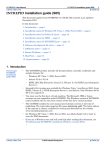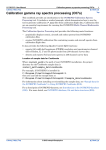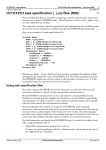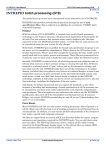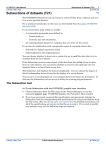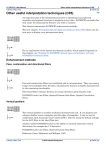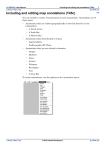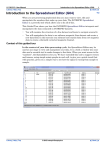Download Depth estimation with the matched filter (C03)
Transcript
INTREPID User Manual Library | Help | Top Depth estimation with the matched filter (C03) 1 | Back | Depth estimation with the matched filter (C03) Top This chapter describes two approaches to depth estimation that use the matched filter: • Separation filtering as described by Cowan and Cowan (1993) • Depth slicing as described by Norman (1993) Spector and Grant (1970) provide a foundation for these techniques. This method uses the power spectrum graph of a magnetics grid in the spectral domain. Magnetic sources at similar depths show straight-line segments in this graph. Location of sample data for Cookbooks Where install_path is the path of your INTREPID installation, the project directory for the Cookbooks sample data is install_path\sample_data\cookbooks. For example, if INTREPID is installed in C:\Program Files\Intrepid\Intrepid4.5, then you can find the sample data at C:\Program Files\Intrepid\Intrepid4.5\sample_data\cookbooks For information about installing or reinstalling the sample data, see "Sample data for the INTREPID Cookbooks" in Using INTREPID Cookbooks (R19). For a description of INTREPID datasets, see Introduction to the INTREPID database (G20). For more detail, see INTREPID database, file and data structures (R05). Separation filter theory This method assumes that you can summarise the power spectrum in terms of two straight line segments, characterising the regional and shallow sources. The slope of a line segment indicates the depth of the sources that it characterises. The intercept with the vertical axis is an indication of the intensity of the source at that depth. Log (Power) Separation Filter B Power Spectrum b Wavenumber Library | Help | Top © 2012 Intrepid Geophysics | Back | INTREPID User Manual Library | Help | Top Depth estimation with the matched filter (C03) 2 | Back | Where B is the Y intercept of the line segment representing the regional sources;b is the Y intercept of the line segment representing the shallow sources;H is the slope of the line segment representing the regional sources;h is the slope of the line segment representing the shallow sources.A1(r) is the regional component of the spectrumA2(r) is the shallow component of the spectrum You can represent the complex spectrum as E(r) = A1(r) + A2(r) Regional component = transfer function Therefore Regional component = complex spectrum / transfer function = complex spectrum. Thus, by applying the transfer function to the complex spectrum, you can obtain the regional component. The matched filter performs this operation. To obtain the shallow component, subtract the calculated regional component from the complex spectrum. The input parameters for the matched filter are b, h, B, H as calculated from the power spectrum graph Depth slicing theory The depth slicing approach (Norman 1993) uses the same transfer function as the separation technique, but assumes that the near surface component is characterised by a horizontal line segment. Log (Power) Depth Slicing B Power Spectrum b=1 Wavenumber The near surface parameters b (intercept) and h (slope) are therefore 1 and 0 respectively. The formula for the regional component is therefore simplified to regional component = spectrum . This is similar to an upward continuation, which is expressed as On calculating the regional component (D1), subtract it from the original spectrum to give the sources from the surface to the top of the regional sources (product S1). Library | Help | Top © 2012 Intrepid Geophysics | Back | INTREPID User Manual Library | Help | Top Depth estimation with the matched filter (C03) 3 | Back | You can repeat the process on product S1 to produce a deep component (D2). subtract the D2 from S1 to give a shallower set of solutions (product S2). You can repeat the process a number of times. The products D1, D2, ... represent 'depth slices' and the products S1, S2, ... represent the residual (shallower) sources in each case. Reference Manual sections See"Querying the power spectrum graph (OldGridFFT)" in Old spectral domain grid filters (OldGridFFT) (T38) for instructions on obtaining the Spector-Grant filter depth estimate, intercept and slope for a straight line segment in a grid’s power spectrum. See "Matched filter (reference)" in INTREPID spectral domain operations reference (R14) for general information about the matched filter in INTREPID. See "Matched Filter (OldGridFFT)" in Old spectral domain grid filters (OldGridFFT) (T38) for instructions on using this filter with grids. Matched filter—worked example Overview This worked example demonstrates the use of the separation filtering approach for extracting the regional component of a survey. You will use the Spectral Domain Grid Filter tool. You will use the power spectrum graph of a grid dataset to calculate intercept and slope for two line segments representing the regional and shallow sources. You will then apply a matched filter with these parameters to the grid dataset and examine the results. Steps to follow Start S D Grid Filters; Specify input and output datasets Library | Help | Top 1 In the INTREPID Project Manager locate the Cookbook interpretation data directory (e.g., d:\intrepid\sample_data\cookbooks\interp_min). 2 Start the Spectral Domain Grid filters tool (FFT_Filter from the Filtering menu) 3 Specify mlevel_grid as the Input Dataset. Specify an Output Dataset (You must output to the grid match_grid1 if INTREPID is running in demonstration mode. We provide an identical solution dataset for you to compare called match_grid). Accept the default forward and reverse FFT options as displayed in the corresponding dialog boxes. © 2012 Intrepid Geophysics | Back | INTREPID User Manual Library | Help | Top Calculate the power spectrum; View the graph Query the graph for deep (regional) sources Depth estimation with the matched filter (C03) 4 | Back | 4 Choose Apply. INTREPID will apply the FFT and generate the power spectrum for the dataset, displaying a ‘Filtering process successfully completed’ message when it has finished. 5 Display the power spectrum graph. (Choose Radial Power Spectrum from the Window menu). 6 Tip: The horizontal axis represents frequency of the data in cycles/km. The vertical axis is the natural logarithm of the energy at that frequency, averaged for all directions in the dataset. Query the graph for the deep (regional) sources Spector-Grant depth estimate. Locate a straight line segment in the low frequency (deep source) range and click each end of it. Note: The straight line must be a segment of the curve, not a tangent to it. INTREPID displays the segment using a white line and report the Y intercept, the slope and Spector-Grant depth estimate for the segment. In our example, (Y intercept) B = –0.84, (– Slope) H = 11.16 km/cycle, Spector-Grant depth estimate = 888 m 7 Library | Help | Top Note the results of the query. Choose OK in the message box and click the display once only, instructing INTREPID to clear the line segment. (It will disappear when you click the first of the next pair of points.) © 2012 Intrepid Geophysics | Back | INTREPID User Manual Library | Help | Top Query the graph for shallow sources 8 Repeat the process with a line segment in the medium frequency (shallow source ) range. This will give you a Spector-Grant estimate of the shallow sources. In our example, (Y intercept) b = –10.9, (– Slope) h = 1.17 km/cycle, Spector-Grant depth estimate = 93 m 9 Specify the Matched filter, then apply it. Note the results of the query. Choose OK in the message box and click the display once only, instructing INTREPID to clear the line segment. 10 Display the Spectral Domain Grid Filters main window (Choose Main FFT from the Window menu). 11 Choose Matched from the Standard menu. INTREPID displays the Matched Filter Coefficients dialog box. Enter the slopes and intercepts that you obtained by querying the graph. Enter them in the following order: shallow intercept (b), – shallow slope (h), deep (regional) intercept (B), – deep (regional) slope (H). Separate each pair of numbers using a space. In our example, you will enter –10.9 Library | Help | Top Depth estimation with the matched filter (C03) 5 | Back | 1.17 –0.84 11.6 © 2012 Intrepid Geophysics | Back | INTREPID User Manual Library | Help | Top Depth estimation with the matched filter (C03) 6 | Back | 12 Choose Apply. INTREPID will apply the filter, and save the output dataset, and display the ‘Filtering process successfully completed’ message when it has finished. The main window will contain a colour display of the filter response and results. Examine the resulting power spectrum graph. 13 Display the power spectrum graph (Choose Radial Power Spectrum from the Window menu). Original data Filtered data Library | Help | Top © 2012 Intrepid Geophysics | Back | INTREPID User Manual Library | Help | Top Depth estimation with the matched filter (C03) 7 | Back | Display the results using the Flight Path Editor or the UNIX visualisation tool. The illustration below shows the original mlevel_grid and the solution dataset we have provided called match_grid. View the filtered grid. Original grid Matched filter results showing basement Tips and further exploration • You must mark the straight-line segment using a straight section of the curve, not a tangent. • To obtain the shallow component of the dataset, subtract the results of the matched filter from the original data. You can do this using the Spreadsheet Editor. Load both grid datasets into the Spreadsheet Editor, where they will occupy adjacent columns. Create a new column with the difference between the grids as the initial value (i.e., mlevel_grid – match_grid). INTREPID will save the new column as a separate grid dataset. • To apply the matched filter using the depth slicing approach with the data used in the worked example, use parameters 1 0 –0.84 11.6 We have provided a task specification (.job) file match_filt.job for the matched filter task. You can edit it and use it as required to experiment with the match filter. Limitations of the matched filter Magnetic source at any depth can be associated with a range of frequencies. Shallow sources can have some low frequency components and there can be some high frequency components associated with deeper sources. Thus, the matched filter only serves to give an indication of the sources at each level rather than conclusive information. Library | Help | Top © 2012 Intrepid Geophysics | Back |







